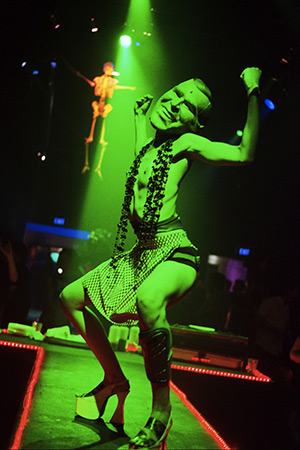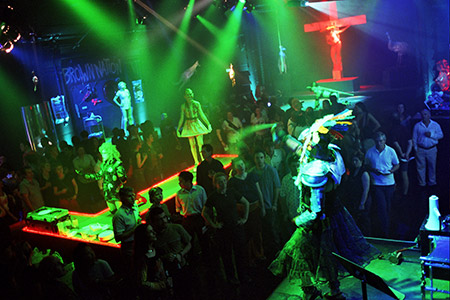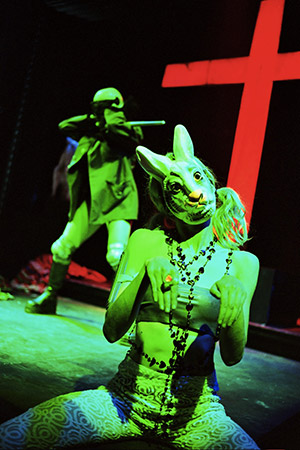The Living Museum of Fetishized Identities
Club Raw was nothing short of amazing, in every connotation of that word. ... Everything is familiar and unfamiliar. ... unforgettable, haunting and eerily attractive imagery.Theatre in Wales
In 2003 and 2004 Knox worked with La Pocha Nostra, a company of performance artists and activists based in USA/Mexico, directed by artist and academic Guillermo Gomez Peña. Assisted by an Australia Council for the Arts Skills and Development grant, she joined an intensive 2-week masterclass at the UK's Centre for Performance Research. Next, she trained with the troupe to devise and present Club Raw at the Castle Theatre, Aberystwyth, Wales.
In 2004 Knox was invited to perform with La Pocha Nostra's core company in The Living Museum of Fetishized Identities, for which she created two post-apocalyptic characters, Raw Bush and Bunny HaHa.
 Pocha Nostra's Raw Club was a dazzlingly brilliant production; an example of interactivity at its best. We were ushered into the lobby, exchanged our currency and waited. The doors opened and a new world awaited us. Suddenly we were on holiday and arriving at an unexpected destination. The best way I can describe the experience is that 'theatre', as we know it, had been disassembled and we were set free to journey through an 'aesthetic space' and in doing so, to become a part of it.
Pocha Nostra's Raw Club was a dazzlingly brilliant production; an example of interactivity at its best. We were ushered into the lobby, exchanged our currency and waited. The doors opened and a new world awaited us. Suddenly we were on holiday and arriving at an unexpected destination. The best way I can describe the experience is that 'theatre', as we know it, had been disassembled and we were set free to journey through an 'aesthetic space' and in doing so, to become a part of it.In Sight / Mewn Golwg
The Living Museum is perhaps best described in the director's own words:
Over the past years, perhaps our most significant contribution to the field has been in our hybrid realm of performance/installation. We create interactive “living museums” that parody various colonial practices of representation. This often includes the ethnographic diorama (as found in museums of natural history), the Freak Show, the Indian Trading Post, the border curio shop, the sex shop/strip joint window display, and their contemporary equivalents in global media and corporate entertainment. We exhibit our highly decorated bodies sometimes as specimens from an endangered tribe or border saints from a persecuted religion. We surrender our will to the audience and assume composite identities dictated by the fears and desires of museum visitors and/or Internet users.

The composite identities of our ethno-cyborg personae are manufactured with the following formula in mind: one quarter stereotype; one quarter audience projection; one quarter aesthetic artifact; and one quarter unpredictable personal/social monster. These artificial savages are cultural projections of First World desire/fear, of its surrounding subcultures, and the so-called Third World Other. The live performance becomes the process via which we reveal the morphology of intercultural fetishes and the mechanisms propelling the behavior of both our “savages” and our audiences.
The audience steps into a total environment. Our ethno-cyborg personae are displayed on platforms of varying heights and sizes for three to four hours a night, sometimes over a three-day period. Live and prerecorded music, multiple video projections and slides, fog, cinematic lighting, embalmed animals, old-fashioned medical figurines and ethno-kitsch design motifs all help to enhance our ethno-techno and robo-baroque aesthetic and create a heightened state for the spectator/participant.
 The experience is purely voyeuristic in the first hour of the performance. The ethno-cyborgs create slow motion emblematic tableaux vivants. A catwalk connecting two platforms becomes a revolving stage for short performances by local artists commenting on fashion, gender and ethnicity. All action happens simultaneously. This ritualized action samples and mixes radical political imagery, religious iconography, extreme pop culture, sports, racially orientated fashion, and theatricalized sexuality. Symbolic sexuality is everywhere. Some performers feel inclined to eroticize political violence and even war while others utilize performative sexuality as syntax to gel religion and politics. Creating symbolic sexuality is also a means to invert power relations and media images of demonized Otherness. These ever morphing tableaux vivants overlap with each other creating surprising juxtapositions and fleeting glances of unique third meanings, which develop above and beyond our original intentions.
The experience is purely voyeuristic in the first hour of the performance. The ethno-cyborgs create slow motion emblematic tableaux vivants. A catwalk connecting two platforms becomes a revolving stage for short performances by local artists commenting on fashion, gender and ethnicity. All action happens simultaneously. This ritualized action samples and mixes radical political imagery, religious iconography, extreme pop culture, sports, racially orientated fashion, and theatricalized sexuality. Symbolic sexuality is everywhere. Some performers feel inclined to eroticize political violence and even war while others utilize performative sexuality as syntax to gel religion and politics. Creating symbolic sexuality is also a means to invert power relations and media images of demonized Otherness. These ever morphing tableaux vivants overlap with each other creating surprising juxtapositions and fleeting glances of unique third meanings, which develop above and beyond our original intentions.
The performative structure is open and non-coercive. Audience members walk around the dioramas designing their own journey. They can stay for as long as they wish, come in and out of the space, return hours later, or even the following day. They can participate in our performance games or simply watch. No one is ever judged.
As the evening evolves, what began as a purely voyeuristic experience becomes increasingly participatory. We begin to make ourselves available for audience members to explore and play with us. They can touch us, smell us, even hand feed us. They can tag (spray-paint) us, braid our hair, change our make-up and props, and try different wigs and headdresses on us. In other words, they get to use the performers as human dolls. They can point guns at us to experience the feeling of having another human surrender at their feet. Some spectators even put dog leashes around our necks and engage in consensual power games with us. Audience members sometimes suggest combinations we’ve not attempted before, in which case we have to try and respond to their challenge. The menu of possible performance interactions changes from site to site.
We often set up a diorama station where audience members can choose a temporary ethnic identity and become their favorite cultural other using make-up and costumes. They are encouraged to integrate themselves into our living dioramas once their instant identity change takes place. Audiences love this part. Almost everyone is willing to escape their ethnicity and gender as long as there are no physical or social repercussions. Again, we don't exercise judgment on anyone.
We also give audience members the option to take off their clothes and symbolically perform their inter-racial sexual fantasies. We are always surprised by the number of people willing to be sexually performative in public. This even happens when we are performing in conservative cities or in countries not used to performance art or experimental theater. (We can’t stress enough that the nature of this play is strictly symbolic and never crosses over to include actual sexual acts. Sometimes it becomes necessary to point this out repeatedly to the audience).
Occasionally we incorporate an open mike in the center of the space to allow audience members to speak up or talk back. They can read their own poetry, voice their opinion on the proceedings, express an outrageous fantasy or desire, or give commands to the performers. We politely persuade them to hand the mike to others if their performance is uninteresting or too long.
Both audience members and performers are continuously making aesthetic, political, and ethical decisions. The subtext of these performance games seems to read: “We are all racist and sexist; we are all horny, tender, playful and violent; it’s human nature; we are all implicated in this madness. Let’s figure it out together. Let’s cross each other's borders and see what happens.” It is precisely in these raw interstices of tolerance/intolerance where we can really further a dialogue on intercultural relations. We try to avoid hollow gestures of sympathy and empathy that superficially transform human relations. Challenging the audience to choose whether or not to participate in this or that performance game means it becomes necessary for them to exercise their civic muscles and political intelligence. We strongly believe that performance furthers dialogue by creating various pathways, trajectories, and unsuspected intersections which are mostly discovered/learned through the body and later circulated through language and action. This is precisely where the true political power of the work lies.
In the last hour of the performance, we reverse the gaze and step out of our dioramas. We then create tableaux vivants with the most responsive and audacious audience members. We manipulate their personae by sculpting their bodies or by adding or subtracting costumes and props. The distance between performer and audience is completely erased. This is our favorite part of the performance.
Inspired by director Richard Gough, we sometimes set up a food station in the performance space where a local chef cooks his/her favorite dishes. These delicious food snacks are sold with names invented by us to suit the atmosphere of the event. We place the audience member in the uncomfortable position of being a cultural tourist by situating the food station right in front of the catwalk (where an extreme fashion show takes place). We also set up a bar inside the performance space. This encourages a carnival atmosphere throughout the experience. The behavior of the audience changes as they become dramatically less inhibited during and after the ingestion of tropical cocktails or shots of strong liquor. This scenario allows for a more revealing performance for both performers and audience members. We are fully aware that this scenario is dangerous, particularly during the last hour when we frequently give up total control of our dioramas. We often find that post-colonial demons are dancing all around us.
Unless we detect the potential for real physical harm, we let all this happen. Why? Our objective (at least the conscious one) is to unleash the millennial demons, not to pontificate. As performance artists we wish to understand our new role and place in this culture of extreme spectacle. We believe that these bizarre millennial rituals and games trigger a long-term process of reflexivity in the psyche of the viewer. We hope this leads to deeper ethical and political questions. This heightened awareness allows spectators to look at and accept images they would usually reject as impossible, distasteful, or unrealistic. Later on, the audience will recall them and will have to deal with their own memories in the cold light of day. This allows them to critically question what they have seen and their feelings towards such imagery.
What the live audience ends up experiencing is a stylized anthropomorphization of their/our own post-colonial demons and hallucinations — a kind of cross-cultural poltergeist. The space between self and other, us and them, fear and desire, becomes blurred and unspecific. It becomes ground zero in intercultural relations. In this sense, the performance/installation functions both as a bizarre set design for a contemporary enactment of cultural pathologies and as a ceremonial space for people to reflect on their attitudes toward other cultures.
For the moment, our job is merely to open the Pandora’s Box of our times and let the demons loose; to open the infected border wound so to speak. Others (academics and activists) will have to help us understand those demons.
Guillermo Gomez Peña, Cross-contamination: The Performance Activism and Oppositional Art of La Pocha Nostra (Manifesto, 2004), in Encrucijada/Crossroads: An Online Academic Journal, Volume 2, Issue 1, 2004
